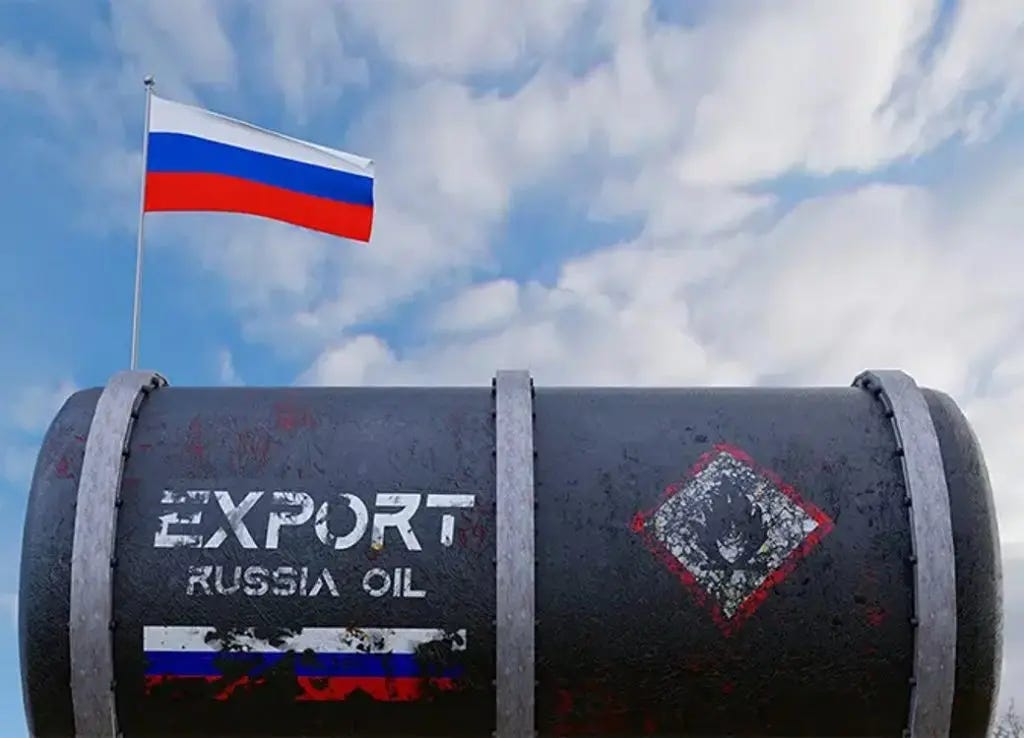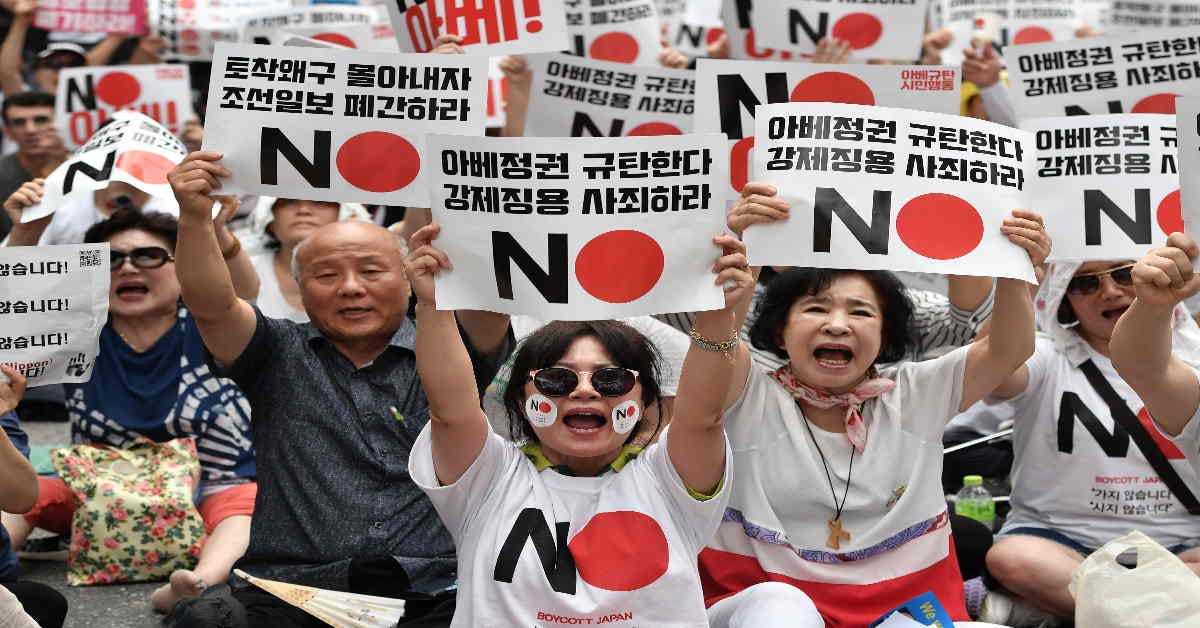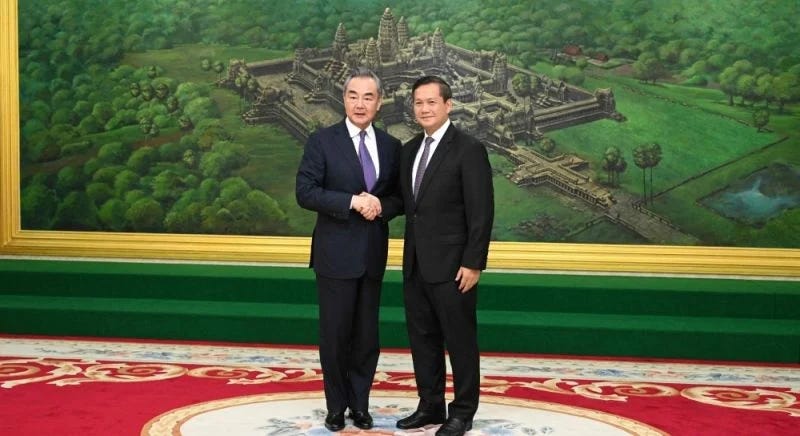Claims and Conduct
UPDATE: A good relationship with the Cambodian government would be a prerequisite for the resumption of negotiations on overlapping claims to natural gas resources in the Gulf of Thailand, experts said, but warned of a return to a cold conflict if there were mutual reservations.
The imminent BRICS expansion could certainly shift the geopolitical power balance, but it is also set to have massive implications for the US. Specifically, the inclusion of certain countries in the BRICS economic alliance could lead to 90% of oil sales no longer being settled in US Dollars.
With the US, Japan and South Korea boosting military linkage, tension is growing in Northeast Asia. While the foreign ministers from the US, South Korea and Japan organise a leaders summit in the US on Aug 18, North Korean leader Kim Jong-un has inspected major munitions factories and called to boost missile production capability, KCNA reported on Monday.
The new Cambodia will maintain the country’s irreversible stance to support the “One China Policy” and non-interference in China's internal affairs. New PM Hun Manet told China’s FM Wang Yi in Phnom Penh.
India is taking major strides to expand its influence in Southeast Asia, a move that will allow countries to counter China’s dominance in the region. Growing rivalry between India and China is seen as influencing New Delhi’s strategic calculation in strengthening its presence.
Pheu Thai could revive talks with Cambodia on gas exploration
By Thai PBS World/Khmer Times (amended)
A good relationship with the Cambodian government would be a prerequisite for the resumption of negotiations on overlapping claims to natural gas resources in the Gulf of Thailand, experts said, but warned of a return to a cold conflict if there were mutual reservations.
The dividends of a diplomatic bonhomie would be high, as together they could exploit an estimated 1 trillion baht worth of energy resources.
Political turmoil and bruised nationalism, mostly in Thailand after the military coup in 2006, became a major impediment for progress in talks between the two countries on demarcating the disputed maritime boundaries as well as jointly developing petroleum reserves in the 26,000 square-kilometre area.
Thailand and Cambodia had signed a memorandum of understanding (MOU) on the areas of their overlapping maritime claims to the continental shelf in June 2001, which became the starting point of negotiations. The two sides, however, were not able to make much progress since then due to political conflicts, mostly in Thailand.
Prior to the 2006 coup, the then government of Prime Minister Thaksin Shinawatra had managed to mark out the delimitation areas where they could undertake joint development. The talks were disrupted by the emergence of a strong anti-Thaksin movement, which accused him of having conflict of interest due to his business cronies and close relations with his Cambodian counterpart, Hun Sen.
The allegation was part of a broader bilateral dispute, as the establishment elite in Thailand opposed a Cambodian proposal to inscribe the Hindu temple of Preah Vihear as a UNESCO World Heritage Site. Heated rhetoric led to military clashes in 2008 and also to the interpretation of the 1962 judgment of the International Court of Justice over ownership of the archaeological site. There were more clashes between soldiers in 2011, inflicting casualties on both sides.
The 2001 MOU itself became a victim of the diplomatic troubles as the Thai government under Abhisit Vejjajiva wanted to terminate it in retaliation for Cambodia’s appointment of Thaksin as Prime Minister Hun Sen’s advisor in 2009. Thaksin was a fugitive at the time under Thai law, facing numerous corruption cases. The MOU, however, survived as the then Thai government failed to formally inform its Cambodian counterpart of its intention to do so.
Governments since then, including the ones led by Thaksin’s sister, Yingluck Shinawatra, and General Prayut Chan-o-cha, who staged a coup in 2014 to topple Yingluck’s administration, have failed to convince Cambodia to return to the negotiating table.
Thailand can no longer afford the loss of economic opportunities to exploit natural resources in the areas of overlapping claims as the gas deposits on the Thai side of the gulf are about to run out, according to Kurujit Nakornthap, executive director of the Petroleum Institute of Thailand.
The country was increasingly dependent on importing liquefied natural gas every year, with consequent pressure on electricity prices domestically. The price of imported gas is US$38.6 per million Btu (British thermal units) — seven times more expensive than the price of gas produced in the Gulf of Thailand, which is only $5.5 per million Btu.
The Thailand-Malaysia joint development model was regarded as a success and stood out as a model for countries in the region. Both Thailand and Cambodia must drop their nationalism and rigid mindset and work towards seeking solutions for mutual benefit.
Thaksin and Yingluck were in the spotlight after they were seen attending Hun Sen’s 72nd birthday celebration in Cambodia recently. The close ties they enjoy with the leadership in the neighbouring country could also rub off on bilateral relations between the two countries, as well as the countries’ mutual economic interests.
However, Dulyapak warned that the new government should be well aware of conflicts of national and personal interests when dealing with the joint development scheme with Cambodia. It could ignite a sense of déjà vu that could eventually jeopardize the negotiations on this matter.
Read more here.
BRICS: 90% of Oil Sales Not in Dollars?
By Joshua Ramos
The imminent BRICS expansion could certainly shift the geopolitical power balance, but it is also set to have massive implications for the US. Specifically, the inclusion of certain countries in the BRICS economic alliance could lead to 90% of oil sales no longer being settled in US Dollars.
A host of countries have sought entry into the BRICS alliance, and many of them hold prominent oil reserves. Additionally, the inclusion of Saudi Arabia and its subsequent shift away from the greenback could alter the international trade market. Moreover, it could fast-track de-dollarization, with notable ramifications for the United States.
The year has been a rather interesting one for the RICS bloc. The collective has undoubtedly faced its most vital moment in time, facing expansion and prominent economic policies. Moreover, those two things could have a massive impact on the geopolitical sector. Transforming the status quo, and shifting the balance of power.
One vital aspect of that depends on what nations are included in the bloc’s expansion efforts. Specifically, the BRICS alliance could lead to 90% of oil sales no longer being settled in US dollars. However, that would hinge on the inclusion of Saudi Arabia into the bloc.
In the 1970s, Saudi Arabia and the Nixon administration struck a notable deal. Subsequently, 50 years later, the country primarily traded in US dollars. Moreover, OPEC allows the entire industry to utilize the greenback, increasing the prominence of the currency on an international level.
Yet Saudi Arabia is now widely believed to be a strong candidate for BRICS inclusion. Additionally, it is already expected to become a valuable part of the BRICS New Development Bank. Thus, it is likely to assist the de-dollarization efforts that the bloc has so embraced over the last year.
This would severely impact the international prevalence of the US dollar, and hinder its viability. Moreover, the other potential additions to the bloc represent 60% of global oil reserves. Therefore, the optimal currency BRICS decides upon will see a massive increase in utilization. Setting forth a strong trajectory for the bloc. Whether that means using a BRICS alternative currency, or specific local currencies, the economic shift will be notable.
Read more here.
US leads Tokyo & Seoul away from peace
By Wang Qi (amended)
With the US, Japan and South Korea boosting military linkage, tension is growing in Northeast Asia. While the foreign ministers from the US, South Korea and Japan organise a leaders summit in the US on Aug 18, North Korean leader Kim Jong-un has inspected major munitions factories and called to boost missile production capability, KCNA reported on Monday.
Pyongyang's move is seen as response to the US-Japan-South Korea military tie-up. Meanwhile, Chinese Defense Ministry announced on Monday that Chinese State Councilor and Defense Minister Li Shangfu will visit Russia, attend the Moscow Conference on International Security and visit Belarus from August 14 to 19.
Analysts pointed out the Asia-Pacific region and even the whole world need to be vigilant about the US' attempt to create a "mini-NATO" in Asia, which would pose a huge threat to regional peace and stability. They also noted that moves by the US and its Asia allies may prompt regional powers such as China and Russia to strengthen substantive strategic cooperation to stabilize the situation.
US President Joe Biden is set to host South Korean President Yoon Suk-yeol and Japanese Prime Minister Fumio Kishida for a trilateral summit at Camp David in Maryland on August 18 (local time), the first stand-alone trilateral summit arranged solely for their shared agenda, according to South Korea's Yonhap News Agency.
Ahead of that, US Secretary of State Antony Blinken is expected to hold a virtual meeting with Japanese foreign minister Yoshimasa Hayashi and South Korean foreign minister Park Jin on Monday, according to the US State Department.
Their virtual meeting will mark that Blinken has talked with his Seoul and Tokyo counterparts in three consecutive months.
Kim Tae-hyo, South Korean deputy national security director, said at a press briefing on Sunday that the leaders will discuss "threats" from North Korea and the core framework of future trilateral security cooperation will be created and institutionalized through the summit. The three nations are expected to launch multiple consultative bodies in the fields of military information sharing, security and the economy, according to South Korean media.
Citing South Korean officials, Yonhap described the summit as marking a "historic turning point" in the trilateral cooperation among Seoul, Washington and Tokyo.
Chinese military expert Song Zhongping told the Global Times on Monday that the US and its Asia allies are establishing a joint defense mechanism, similar to NATO, to strengthen joint capabilities in military command, early warning, missile technology and other areas.
The move is ostensibly aimed at North Korea, but its real target is China, Song said, noting that the closer, normalized and institutionalized military cooperation among the three countries will lead to an escalation of the situation in Northeast Asia and even the Asia- Pacific region.
The US, Japan and South Korea are moving from two bilateral alliances centered on the US to a trilateral alliance, Li Haidong, a professor at the China Foreign Affairs University, told the Global Times on Monday.
This is a step by the US to build a "mini NATO" in the Asia-Pacific region, and it shows the way the US and its allies strengthen ties is through creating instability, division and even crisis, which means regional countries and even the whole world must be vigilant, Li said.
Japan's Yomiuri newspaper said on Sunday that the US and Japan are expected to sign an agreement to jointly develop an interceptor missile in an effort to counter hypersonic warheads developed by China, Russia and North Korea. Japan and the US also plan to strengthen cooperation to enhance intelligence-gathering capabilities.
On July 16, Japan, South Korea and the US held a joint naval missile defense exercise. Two days later, the US deployed a nuclear-capable submarine to South Korea for the first time in four decades.
According to Li Haidong, the aggressive moves by the US and its Asia allies will become a driving force for China and Russia to further consolidate and deepen strategic cooperation in the Asia-Pacific region and globally.
China and Russia need to strengthen strategic coordination and cooperation in many aspects, and the content must be substantive, he added.
China is an important force to maintain stability in the Asia-Pacific region, but China also needs to be well-prepared to deal with emergencies and even military conflicts ignited by US and its allies, Song noted.
Read more here.
Cambodian PM Upholds “One China Policy”
The new Royal Government of Cambodia will maintain the country’s irreversible stance to support the “One China Policy” and non-interference in China's internal affairs. The stance was underscored by H.E. Kitti Tesaphibal Pundit Hun Manet while receiving H.E. Wang Yi, Member of the Political Bureau of the Central Committee of the Communist Party of China, Director of the Office of the Central Commission for Foreign Affairs, and Minister of Foreign Affairs of the People’s Republic of China, at the Peace Palace in Phnom Penh this afternoon.
At the same time, H.E. Kitti Tesaphibal Pundit Hun Manet accepted the invitation to attend the commemoration of the 10th Anniversary of the Belt and Road Initiative in Beijing, China in mid-October this year.
For his part, Wang Yi reaffirmed China’s commitment to continue the effective and close collaboration with Cambodia, and its readiness to welcome the official visit and participation of H.E. Kitti Tesaphibal Pundit Hun Manet in the 20th China-ASEAN Expo 2023 to be held in China’s Nanning city in mid-September.
Both leaders pledged to further promote the cooperation between Cambodia and China by maintaining the past achievements as well as expanding the direction of cooperation in new areas such as electricity, especially hydropower, infrastructure, agriculture, trade, etc.
They also agreed to continue both countries’ cooperation and mutual support in the regional and international framework.
Read more here.
India seeks to counter China in SEA
By Sumathi Bala (amended)
India is taking major strides to expand its influence in Southeast Asia, a move that will allow countries to counter China’s dominance in the region. Growing rivalry between India and China is seen as influencing New Delhi’s strategic calculation in strengthening its presence.
“I think the understanding in New Delhi had been: Let’s not wade into waters where China might be more uncomfortable,” Pant told CNBC, adding that Beijing has “enormous potential to create trouble for India.”
Since China hasn’t “budged” on the border issue, India “now feels there has been no real return for its cautious attitude towards Southeast Asia,” he added.
In June, India’s external affairs minister Subrahmanyam Jaishankar, highlighted the border conflict was affecting relations between the two countries.
In recent months, Prime Minister Narendra Modi’s government has stepped up its outreach to regional countries aimed at balancing Beijing.
The move reinforces India’s ongoing comprehensive strategic partnership with Southeast Asia.
In June, New Delhi said it was giving a naval warship to Vietnam, in the latest sign of growing defense ties between both nations, said Satoru Nagao, non-resident fellow at Hudson Institute, based in Tokyo.
“India also trains pilots and ground crew of fighter jets of the Vietnam Air Force. Indian naval ships visited Vietnam constantly,” he added.
Vietnam is now planning to buy supersonic missiles and surface-to-air missiles from India, said Nagao, who specializes in defense strategy, foreign policy and security alliances.
“India’s ‘Look East’ policy began in 1991, but by 2014, when Modi turned the policy into ‘Act East,’ it was apparent that the region and world was dealing with a different kind of China.
India caused a stir in late June when its foreign minister and his Filipino counterpart, Enrique Manalo, issued a joint statement, urging China to abide by The Hague’s 2016 arbitration decision on the South China Sea.
The joint statement sparked speculation that New Delhi was shifting away from its neutral posture on competing territorial claims in the region.
India “is bolstering strategic ties — diplomatic, economic, and security — to Southeast Asian states to help them balance or hedge against, or outright counter Chinese power,” said Rand’s Grossman.
“This is particularly salient to the maritime sphere, namely the South China Sea, where overlapping sovereignty disputes threaten regional stability and openness,” he added.
China’s expanding influence through its Belt and Road Initiative in Southeast Asia is also driving India’s calculation, according to Joanne Lin, co-coordinator of the ASEAN Studies Centre at ISEAS, at Yusof Ishak Institute in Singapore.
Most countries in the region have supported China’s mega infrastructure project— Xi’s signature policy initiative aimed at expanding Beijing’s influence through a network of road, rail and sea connections across Asia, Europe and the Middle East.
Readjusting to an evolving international order defined primarily by the China-U.S. rivalry has also proven particularly challenging for Southeast Asian countries.
They see India as an “important piece of a broader strategy of shaping a more multipolar order rather than one that is centered around China or dominated by U.S.-China bipolar competition,” he added.
“India is the third top option for the region in hedging against the uncertainties of the US-China rivalry. China continues to be regarded as the most influential economic power by 59.9% of the respondents.
China will be “cautious” about the developments, said Lin from ISEAS. “India’s growing influence in Southeast Asia and enhanced defense cooperation,” among other issues “will cause unease in Beijing,” she added.
Pant noted: “China will be watching this carefully and sending its own messages out.”
But given Southeast Asia “is a central pillar to India’s own Indo-Pacific strategy,” that will not deter New Delhi,” he added. “India’s push into the region will only continue to gather momentum.”
Read more here.









